Genesis of Carbonate Breccia Containing Invisible Gold in Taebaeksan Basin, South Korea
Abstract
1. Introduction
2. Geological Setting
2.1. Regional Geology
2.2. Local Geology
3. Methods
3.1. Sampling and Carbonate Staining
(solution) (solid) (liquid)
3.2. Electron Probe Microanalysis
4. Results
4.1. Morphological Features of the Yemi Breccia
4.2. Occurrence of Metallic Minerals (Mainly Pyrite and Hematite) in Yemi Breccia
4.3. Occurrence of Gold in Yemi Breccia
5. Discussion and Conclusions
Author Contributions
Funding
Acknowledgments
Conflicts of Interest
References
- Kim, O.J.; Kwon, Y.S. Geology of Euirimgil and its vicinity: Special emphasis on the so-called Yemi Limestone Breccia Bed. J. Geol. Soc. Korea 1970, 6, 213–220. [Google Scholar]
- Reed, A.J.; Um, S.H. The Geology of Korea; Geological and Mineral Institute of Korea: Seoul, Korea, 1975; p. 139. [Google Scholar]
- Cluzel, D. Formation and tectonic evolution of early Mesozoic intramontane basins in the Ogcheon belt (South Korea): A reappraisal of the Jurassic “Daebo orogeny”. J. Southeast Asian Earth Sci. 1992, 7, 223–235. [Google Scholar] [CrossRef]
- Woo, K.S. Yemi breccia: The origin and stratigraphic meaning. Korean J. Pet. Geol. 1997, 5, 16–26. [Google Scholar]
- Ryu, I.C. Tectonic and stratigraphic significance of the Middle Ordovician carbonate breccias, Ogcheon Belt, South Korea. Isl. Asrc 2002, 11, 149–169. [Google Scholar] [CrossRef]
- Kunsky, J. Thermomineral karst caves of Zbrashov, northern Moravia. Sbor. Cs. Spol. Zemepis. 1957, 62, 306–351. [Google Scholar]
- Maksimovich, B. Geologic and Tectonic Relations of Coal-Bearing Senjsko-Resavski Mine and Surrounding Areas; Jovan, Z., Ed.; Geological Institute: Beograd, Serbia, 1956; p. 104. (In Slovenian) [Google Scholar]
- Tucker, M.J.; Hart, C.J.R.; Carne, R.C. Geology, alteration, and mineralization of the Carlin-type Conrad zone, Yukon. In Yukon Exploration and Geology 2012; MacFarlane, K.E., Nordling, M.G., Sack, P.J., Eds.; Yukon Geological Survey: Whitehorse, YT, Canada, 2013; pp. 163–178. [Google Scholar]
- Smith, M.T.; Rhys, D.; Ross, K.; Lee, C.; Gray, J.N. The Long Canyon Deposit: Anatomy of a New Off-Trend Sedimentary Rock-Hosted Gold Discovery in Northeastern Nevada. Econ. Geol. 2013, 108, 1119–1145. [Google Scholar] [CrossRef]
- Dean, G.; Heitt, W.; Warren, D.; Tommy, B.; Thompson, R.; Jackson, G. Geology and Geochemistry of the Deep Star Gold Deposit, Carlin Trend, Nevada. Econ. Geol. 2003, 98, 1107–1135. [Google Scholar] [CrossRef]
- Andreychouk, V.; Dublyansky, Y.; Ezhov, Y.; Lysenin, G. Karst in the Earth’s Crust: Its Distribution and Principal Types; University of Silesia and Ukrainian Institute of Speleology and Karstology, Sosnowiec (Poland)-Simferopol (Ukraine): Sosnowiec, Poland, 2009; p. 72. [Google Scholar]
- Gustin, M.M.; Smith, M.T. Technical Report on the Long Canyon Project, Elko County, Nevada, USA: Canadian National Instrument 43-101 Technical Report; Fronteer Development Group Inc.: Reno, NV, USA, 2009; p. 126. [Google Scholar]
- Gustin, M.M.; Smith, M.T.; Simmons, G.L. Updated Technical Report on the Long Canyon Project, Elko County, Nevada, USA; Canadian National Instrument 43-101 Technical Report; Fronteer Development Group Inc.: Reno, NV, USA, 2010; p. 137. [Google Scholar]
- Williams, C.L. Breccia bodies in the Carlin trend, Elko and Eureka Counties, Nevada: Classification, Interpretation, and Roles in Ore Formation. Master’s Thesis, Colorado State University, Fort Collins, CO, USA, 1992; p. 213. [Google Scholar]
- Alvarez, W.; Belza, J.; Chan, L.S.; Claeys, P.; Geiser, P.; Menichetti, M.; Shimabukuro, D.H.; Tavarnelli, E. Expansion breccias in Lower Cretaceous Apennine pelagic limestones: I. Geological observations. In 250 Million Years of Earth History in Central Italy: Celebrating 25 Years of the Geological Observatory of Coldigioco: Geological Society of America Special Paper; Koeberl, C., Bice, D.M., Eds.; The Geological Society of America: Boulder, CO, USA, 2019; Volume 542. [Google Scholar] [CrossRef]
- Belza, J.; Alvarez, W.; Tavarnelli, E.; Vanhaecke, F.; Baele, J.-M.; Claeys, P. Expansion breccias in Lower Cretaceous Apennine pelagic limestones: II. Geochemical constraints on their origin. In 250 Million Years of Earth History in Central Italy: Celebrating 25 Years of the Geological Observatory of Coldigioco: Geological Society of America Special Paper; Koeberl, C., Bice, D.M., Eds.; The Geological Society of America: Boulder, CO, USA, 2019; Volume 542. [Google Scholar] [CrossRef]
- Sass-Gustkiewicz, M. Collapse breccia in the ore-bearing dolomite of the Olkusz mine. Ann. Soc. Geol. Pol. 1974, 44, 217–226. [Google Scholar]
- Lubben, J.D. Silicification across the Betze-Post Carlin-Type Au Deposit: Clues to Ore Fluid Properties and Sources, Northern Carlin Trend, Nevada. Ph.D. Thesis, University of Nevada, Las Vegas, NV, USA, 2004. [Google Scholar]
- Chough, S.K.; Kwon, S.T.; Ree, J.H.; Choi, D.K. Tectonic and sedimentary evolution of the Korean peninsula: A review and new view. Earth-Sci. Rev. 2000, 52, 175–235. [Google Scholar] [CrossRef]
- Joo, H.; Ryu, I.C. Sedimentary facies of the Cambrian Sesong formation, Taebacksan basin. J. Econ. Environ. Geol. 2012, 45, 565–578. [Google Scholar] [CrossRef]
- Geological Investigation Corps of Taebaegsan Region (GICTR). Geological Maps of Taebaegsan Region; Geological Survey of Korea and Geological Society of Korea: Seoul, Korea, 1962. [Google Scholar]
- Korea Resources Corporation. Detailed Reserch Report, DS2001-LS(I); Korea Resources Corporation: Wonju-si, Korea, 2001. [Google Scholar]
- Cluzel, D.; Cadet, J.P.; Lapierre, H. Geodynamics of the Okcheon belt (South Korea). Tectonophysics 1990, 183, 41–56. [Google Scholar] [CrossRef]
- Cluzel, D.; Jolivet, L.; Cadet, J.P. Early middle Paleozoic intraplate orogeny in the Okcheon belt (South Korea), a new insight on the Paleozoic buildup of east Asia. Tectonics 1991, 10, 1130–1151. [Google Scholar] [CrossRef]
- Kim, J.H.; Lee, J.Y.; Nam, K.H. PreJurassic thrust movement in Danyang area, Danyang coalfield, Korea. J. Geol. Soc. Korea 1994, 30, 35–40. [Google Scholar]
- Kim, J.H.; Lee, J.D. Geologic structures of the Yemi area, Kangweon-do, Korea. J. Geol. Soc. Korea 1991, 27, 500–514. [Google Scholar]
- Kim, B.K. Some new geological aspects revealed from the northwestern part of the Yemi area. J. Geol. Soc. Korea 1969, 5, 229–241. [Google Scholar]
- Min, K.D.; Cho, K.E. Gravity survey of the subsurface geology and geologic structure between Samcheog and Taebaek Area. Econ. Environ. Geol. 1995, 28, 79–88. [Google Scholar]
- The Geological Society of Korea. Geology of Korea (Seoul, South Korea); Sigma Press: Seoul, Korea, 1999; p. 802. (In Korean) [Google Scholar]
- Laznicka, P. Breccias and Coarse Fragmentites: Petrology, Environments, Associations, Ores; Elsevier: Amsterdam, The Netherlands; New York, NY, USA, 1988; Volume 25, p. 832. [Google Scholar]
- Hofstra, A.H.; Cline, J.S. Characteristics and Models for Carlin-Type Gold Deposits. Rev. Econ. Geol. 2000, 13, 163–220. [Google Scholar]
- Large, R.R.; Maslennikov, V.V. Invisible Gold Paragenesis and Geochemistry in Pyrite from Orogenic and Sediment-Hosted Gold Deposits. Minerals 2020, 10, 339. [Google Scholar] [CrossRef]
- Su, W.; Xia, B.; Zhang, H.; Zhang, X.; Hu, R. Visible gold in arsenian pyrite at the Shuiyindong Carlin-type gold deposit, Guizhou, China: Implications for the environment and processes of ore formation. Ore Geol. Rev. 2008, 33, 667–679. [Google Scholar] [CrossRef]
- Su, W.; Zhang, H.; Hu, R.; Ge, X.; Xia, B.; Chen, Y.; Zhu, C. Mineralogy and geochemistry of gold-bearing arsenian pyrite from the Shuiyindong Carlin-type gold deposit, Guizhou, China: Implications for gold depositional processes. Miner. Depos. 2012, 47, 653–662. [Google Scholar] [CrossRef]
- Flügel, E. Microfacies of Carbonate Rocks: Analysis, Interpretation and Application; Springer: Berlin, Germany, 2004. [Google Scholar]
- Ryu, I.C.; Doh, S.J.; Choi, S.G. Carbonate breccias in the lower-middle Ordovician Maggol limestone (Taebaeksan Basin, South Korea): Implications for regional tectonism. Facies 2002, 46, 35–56. [Google Scholar] [CrossRef]
- Frédéric, B.; Michel, S.; Alexis, M. Coarse carbonate breccias as a result of water-wave cyclic loading (uppermost Jurassic–South-East Basin, France). Sedimentology 2001, 48, 767–789. [Google Scholar]
- Seguret, M.; Moussine-Pouchkine, A.; Gabaglia, G.R.; Bouchette, F. Storm deposits and storm-generated coarse carbonate breccias on a pelagic outer shelf (South-East Basin, France). Sedimentology 2001, 48, 231–254. [Google Scholar] [CrossRef]
- Payros, A.; Pujalte, V.; Orue-Etxebarria, X. The South Pyrenean Eocene carbonate megabreccias revisited: New interpretation based on evidence from the Pamplona Basin. Sediment. Geol. 1999, 125, 165–194. [Google Scholar] [CrossRef]
- Hong, Q. The carbonate gravity flow sediments in the juncture of Yunnan, Guizhou and Guangxi. J. Southwest Pet. Inst. 1982, 4, 1–11. [Google Scholar]
- Mei, Z.; Chen, J.; Lu, H.; Li, H. Deep water carbonate debris flow in the middle Ordovician Pingliang formation of Fuping, Shaanxi. Oil Gas Geol. 1982, 3, 49–56. [Google Scholar]
- Carbonate Rock Research Office. Deep water carbonate brecclas in the Nanpan river area during the Permian and Triassic periods. J. Southwest Pet. Inst. 1982, 4, 1–26. [Google Scholar]
- Luo, Z. Preliminary study on Triassic and late Paleoxoic reef facies in Yunnan-Guizhou-Guangxi region and their Petroleum prospect. Exp. Pet. Geol. 1983, 5, 18–28. [Google Scholar]
- Du, Y.; Li, S.; Jia, Z.; Wang, S. Re-discussion on the origin of the rudstone in Middle Permian Qixia Formation along Lower Yangtze River of Anhui Province. Geol. Rev. 2012, 58, 426–433. [Google Scholar]
- Blount, D.N.; Moore, C.H. Depositional and non-depositional carbonate breccias, Chiantla Quadrangle, Guatemala. Geol. Soc. Am. Bull. 1969, 80, 429–442. [Google Scholar] [CrossRef]
- Morrow, D.W. Descriptive field classification of sedimentary and diagenetic breccia fabrics in carbonate rocks. Bull. Can. Pet. Geol. 1982, 30, 227–229. [Google Scholar]
- Liu, H.; Ma, T.; Tan, X.; Zeng, W.; Hu, G.; Xiao, D.; Luo, B.; Shan, S.; Su, C. Origin of structurally controlled hydrothermal dolomite in epigenetic karst system during shallow burial: An example from Middle Permian Maokou Formation, central Sichuan Basin, SW China. Pet. Explor. Dev. 2016, 43, 1000–1012. [Google Scholar] [CrossRef]
- Li, W.; Zhang, Y.; Zhang, B.; Li, J.; Wang, J.; Ma, X. Origin, characteristics and significance of collapsed-paleocave systems in Sinian to Permian carbonate strata in Central Sichuan Basin, SW China. Pet. Explor. Dev. 2014, 41, 513–522. [Google Scholar] [CrossRef]
- Wilshire, H.G.; Howard, K.A.; Offield, T.W. Impact breccias in carbonate rocks, Sierra Madera, Texas. Geol. Soc. Am. Bull. 1971, 82, 1009–1017. [Google Scholar] [CrossRef]
- Tarasewicz, J.P.T.; Woodcock, N.H.; Dickson, J.A.D. Carbonate dilation breccias: Examples from the damage zone to the Dent Fault, northwest England. Geol. Soc. Am. Bull. 2005, 117, 6722–6723. [Google Scholar] [CrossRef]
- Kutyrev, E.I.; Michailov, B.M.; Liakhnitsky, Y.S. Karstovye 68 Mestorozdenia (Karstic Mineral Deposits); Nedra: Leningrad, Russia, 1989; p. 311. (In Russian) [Google Scholar]
- Dristas, J.A.; Martinez, J.C.; Kerkhof, A.M.; Massonne, H.J.; Theye, T.; Frisicale, M.C.; Gregori, D.A. Hydrothermal karst and associated breccias in Neoproterozoic limestone from the Barker-Villa Cacique area (Tandilia belt), Argentina. J. S. Am. Earth Sci. 2017, 76, 182–197. [Google Scholar] [CrossRef]
- Reich, M.; Kesler, S.E.; Utsunoyiya, S.; Palenik, C.S.; Chryssoulis, S.; Ewing, R.C. Solubility of gold in arsenian pyrite. Geochim. Cosmochim. Acta 2005, 69, 2781–2796. [Google Scholar] [CrossRef]
- Arehart, G.B.; Eldridge, C.S.; Chryssoulis, S.L.; Kesler, S.E. Ion microprobe determination of sulfur isotope variations in iron sulfides from the Post/Betze sediment-hosted disseminated gold deposit, Nevada, USA. Geochim. Cosmochim. Acta 1993, 57, 1505–1519. [Google Scholar] [CrossRef]
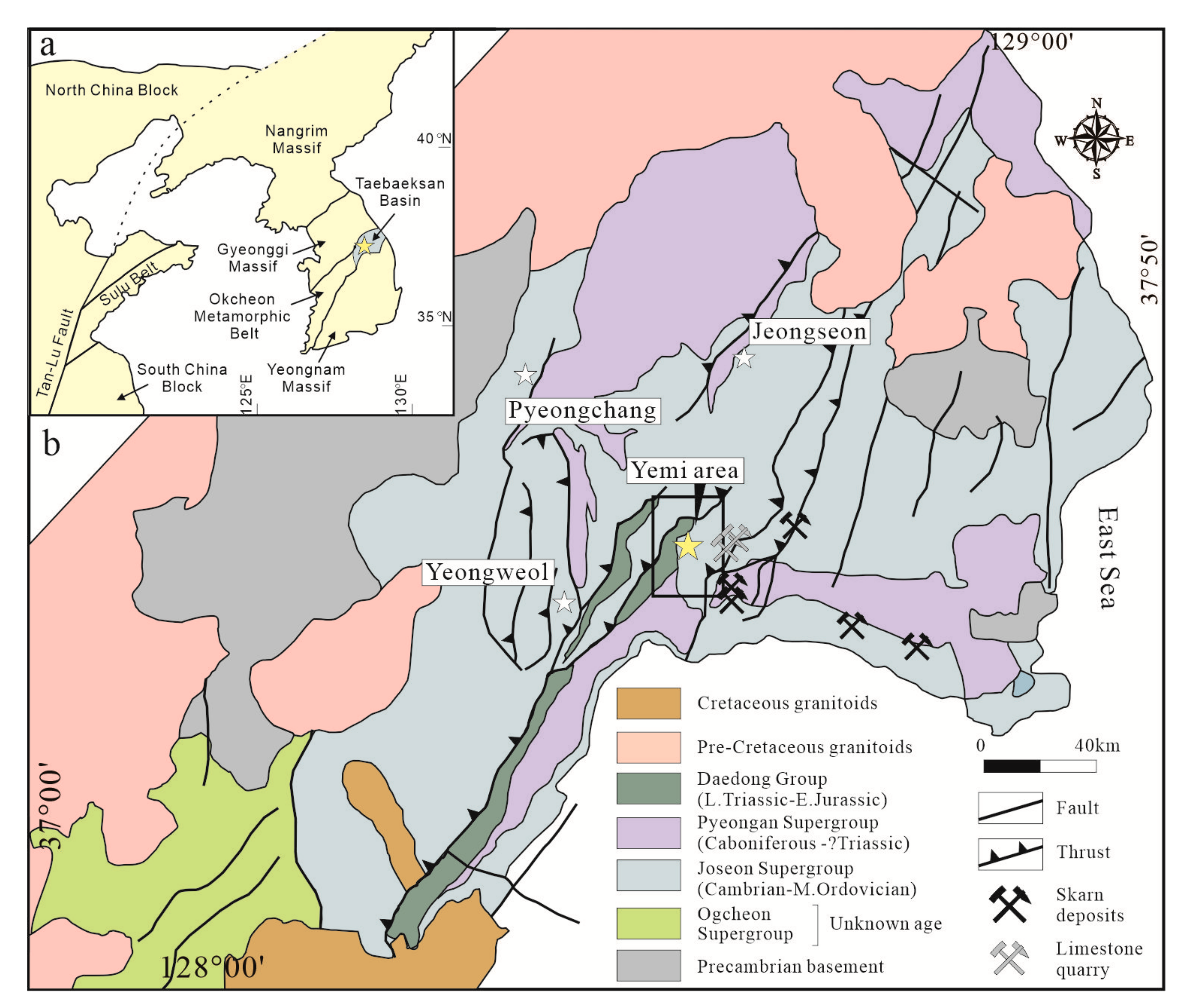
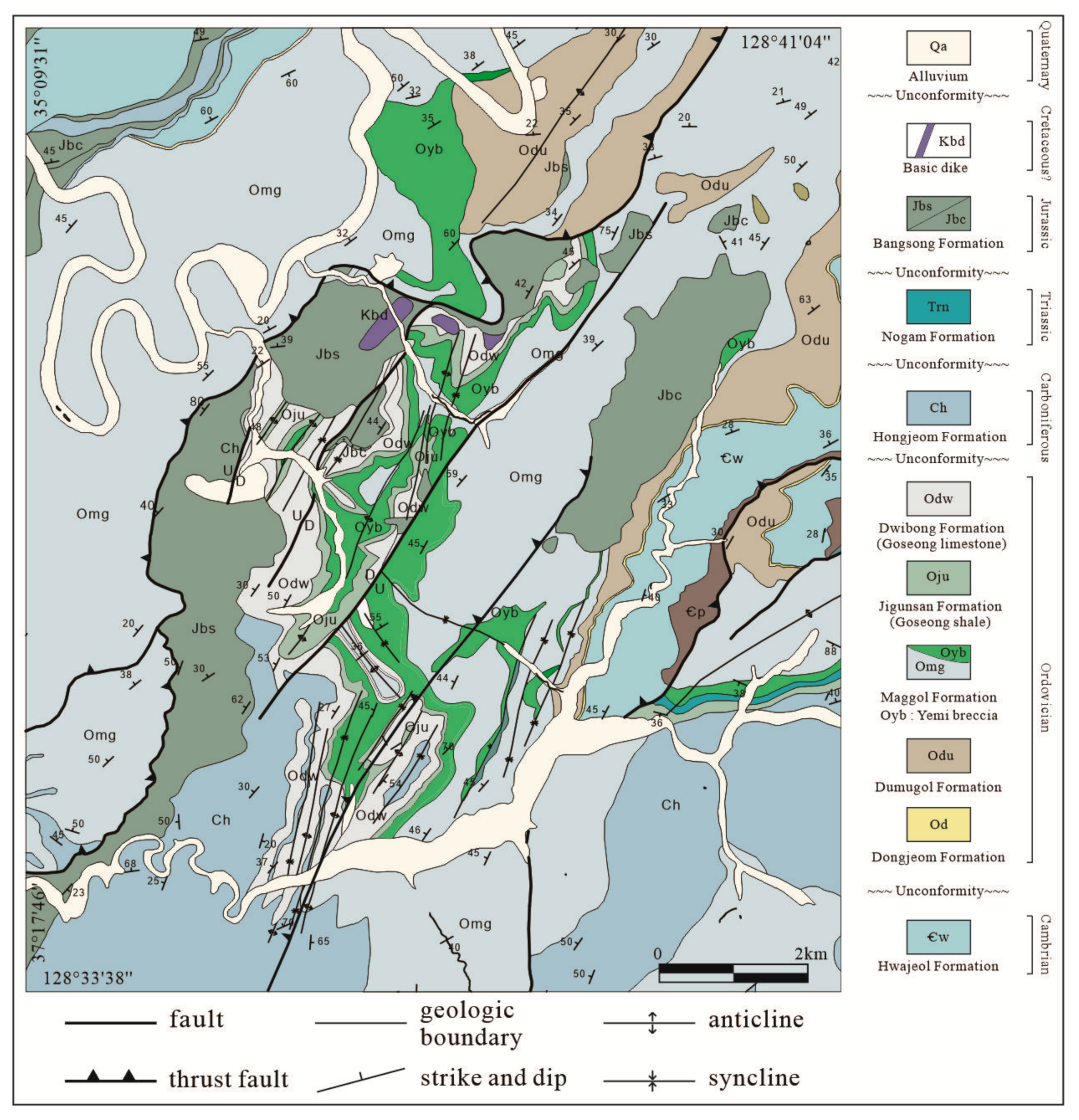
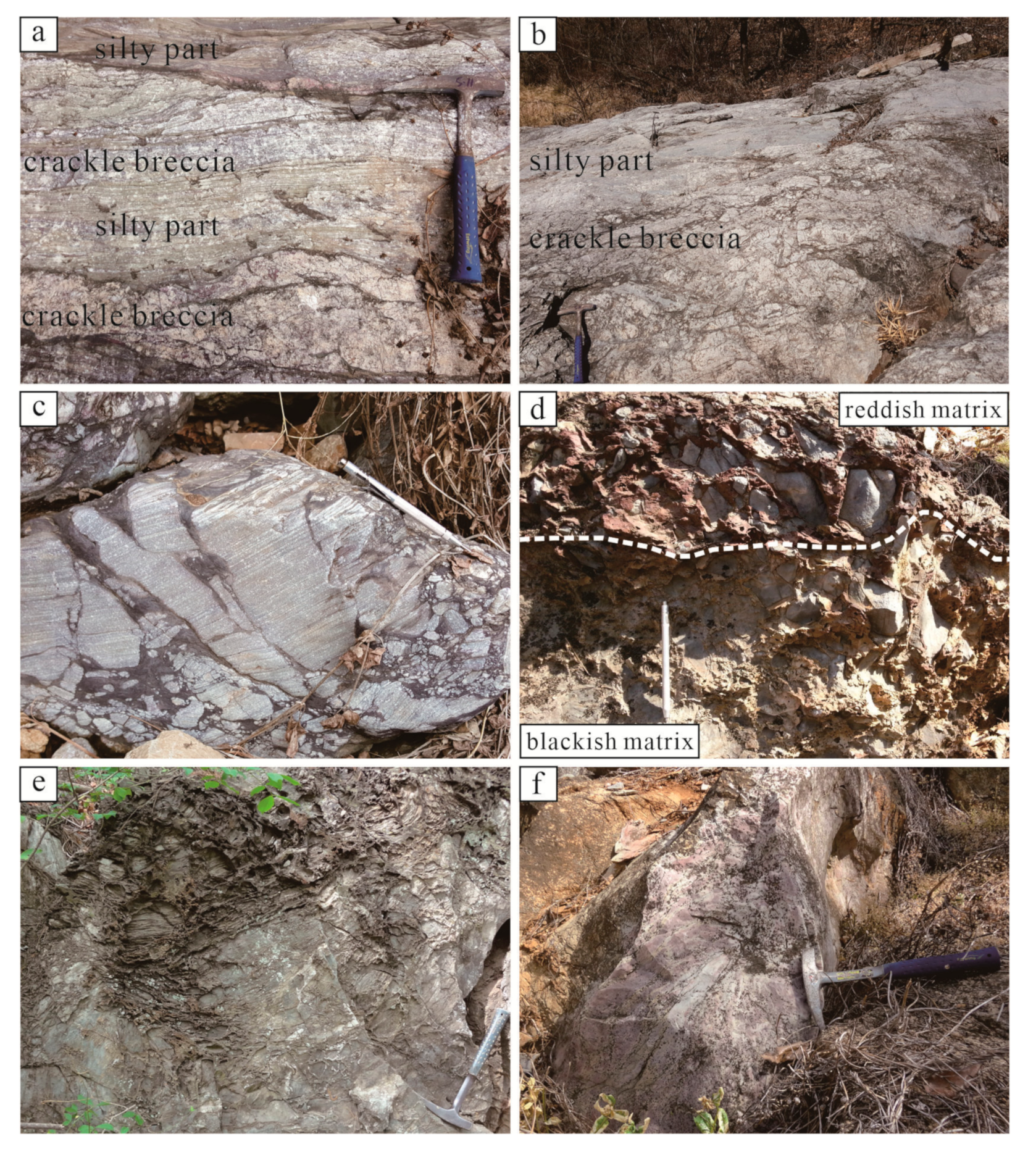
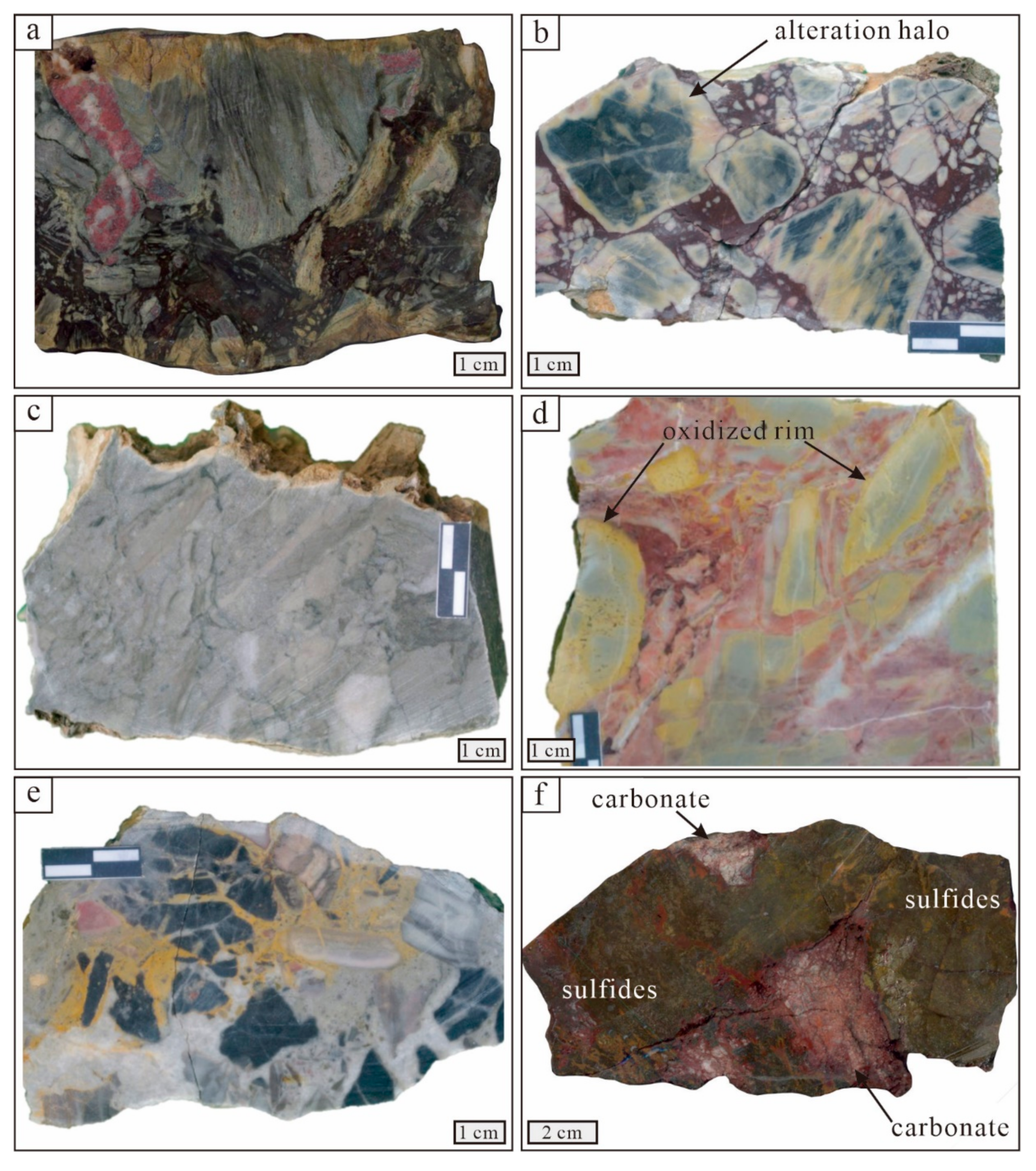
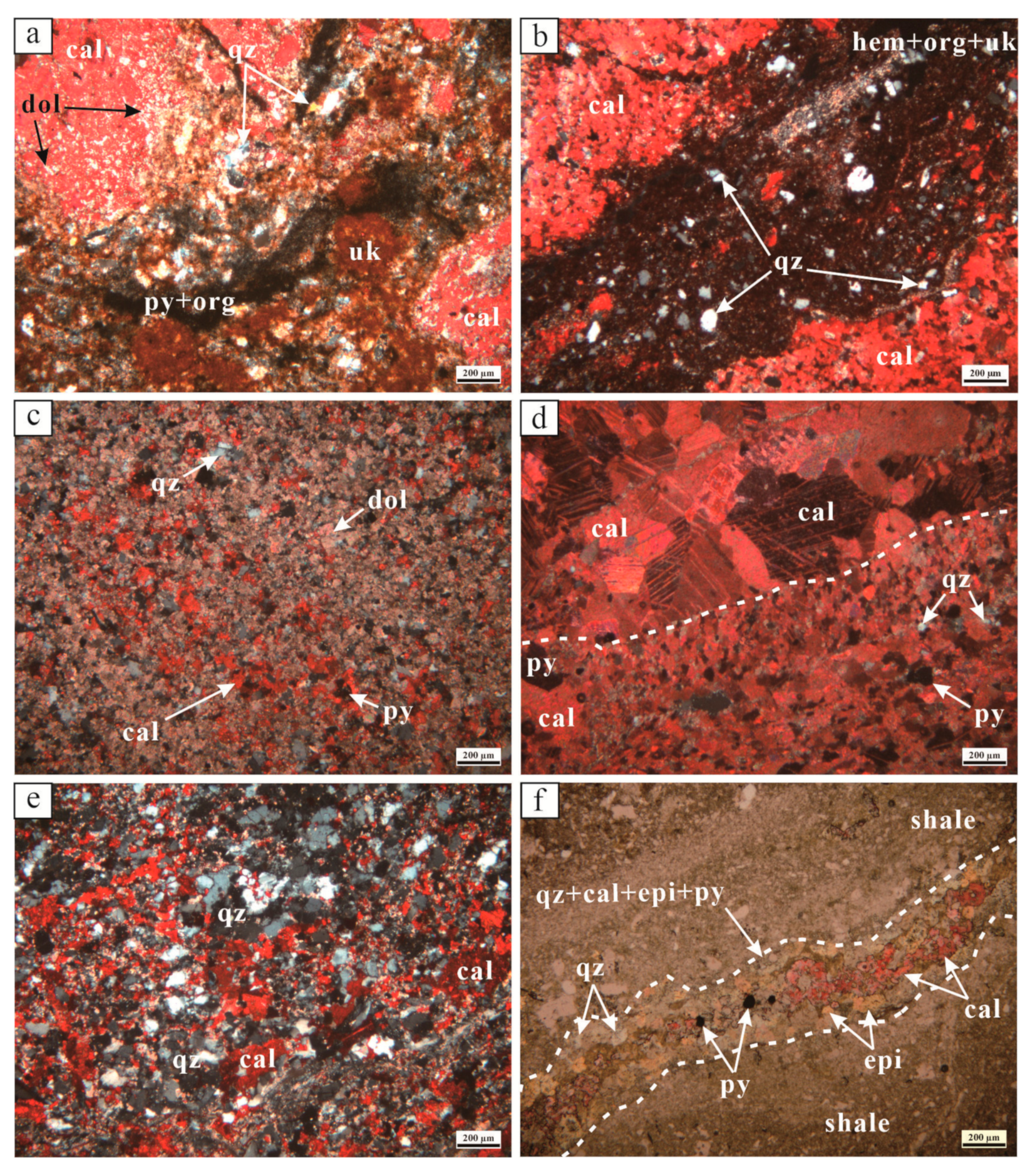
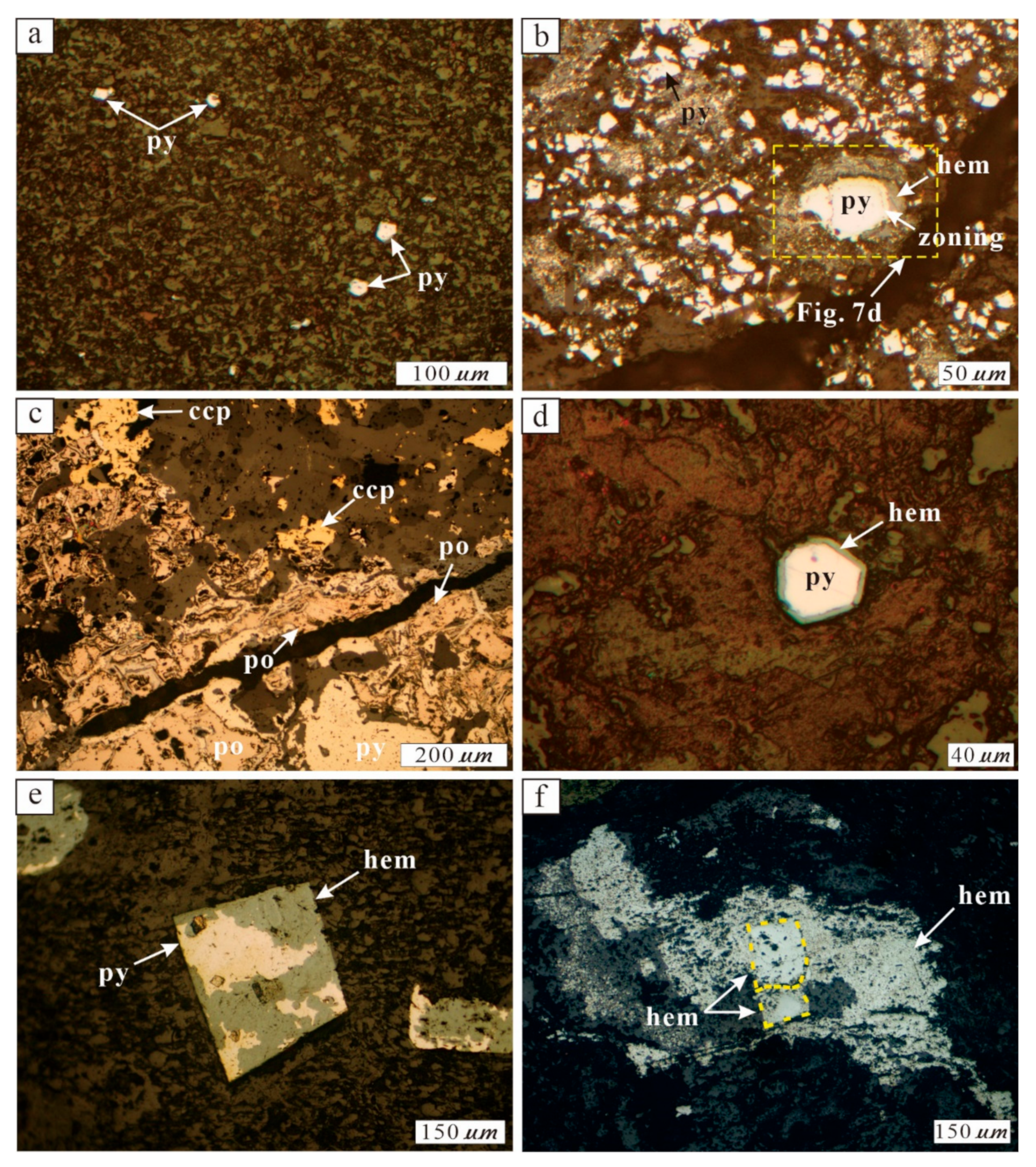
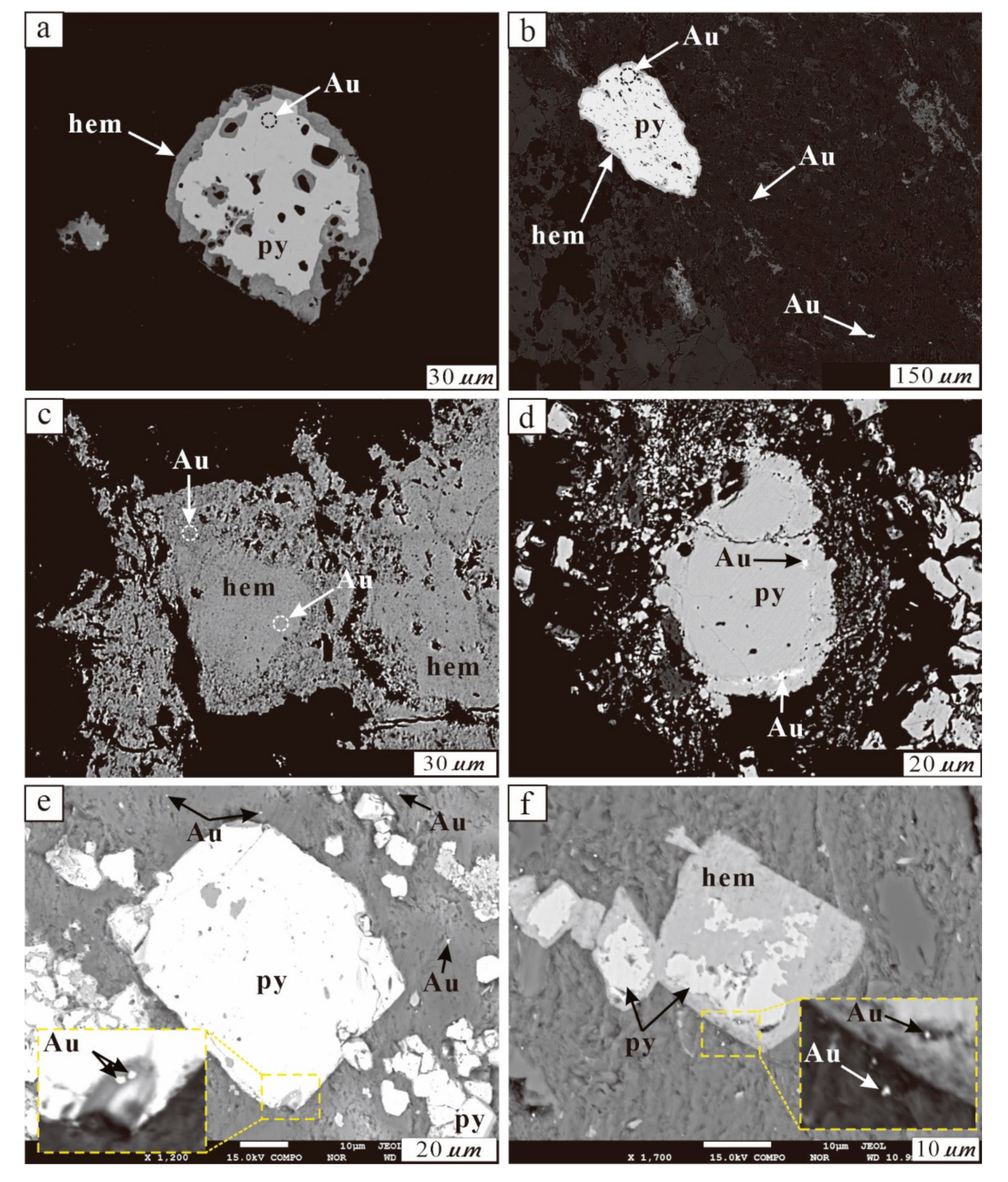
| Classes | Minerals | Remarks |
|---|---|---|
| Blackish | qz + cal + py + org (+ ep + chl) | Disseminated pyrite, insoluble matter |
| Reddish | qz + cal + hem (+ org) | Disseminated hematite, alteration halo |
| Gray | cal + org + py (+ qz) | Disseminated pyrite, crystalline calcite |
| White to pinkish | cal + py + qz | Crystalline calcite, oxidized rim |
| Mineral | Size | Morphology | Remarks | |
|---|---|---|---|---|
| Type 1 | Pyrite | <20 µm | Euhedral | Disseminated |
| Type 2 | Pyrite Pyrrhotite Chalcopyrite | 20–300 µm >200 µm >200 µm | Euhedral to anhedral, irregular | Disseminated, replacement, overgrowth |
| Type 3 | Hematite | 10–200 µm | Euhedral to anhedral, pseudomorph | Disseminated, replacement, overgrowth, overgrowth/replacement |
| No. | Spot | Fe | Zn | Cu | O | Au | Ag | Sb | S | Co | Pb | Total |
|---|---|---|---|---|---|---|---|---|---|---|---|---|
| 1 | Pyrite | 47.45 | <0.01 | 0.04 | 3.02 | 0.68 | 0.02 | <0.01 | 49.20 | 0.12 | <0.01 | 100.55 |
| 2 | Pyrite | 45.37 | <0.01 | 0.02 | 0.45 | 0.37 | 0.01 | <0.01 | 53.02 | <0.01 | <0.01 | 99.24 |
| 3 | Pyrite | 45.4 | <0.01 | <0.01 | 0.26 | 0.01 | <0.01 | <0.01 | 53.3 | 0.13 | 0.25 | 99.32 |
| 4 | Pyrite | 33.1 | <0.01 | 0.06 | 0.66 | 0.15 | <0.01 | 0.06 | 43.9 | 0.34 | 14.43 | 93.08 |
| 5 | Pyrite | 30.89 | <0.01 | 0.04 | 1.75 | 1.54 | <0.01 | <0.01 | 31.93 | <0.01 | <0.01 | 66.61 |
| 6 | Pyrite | 35.67 | 0.01 | 0.03 | 1.61 | 0.08 | 0.02 | <0.01 | 36.14 | <0.01 | <0.01 | 73.80 |
| 7 | Pyrite | 40.15 | <0.01 | 0.04 | 2.46 | 0.03 | 0.01 | <0.01 | 49.49 | <0.01 | <0.01 | 92.37 |
| 8 | Hematite | 68.7 | <0.01 | <0.01 | 37.8 | 0.07 | <0.01 | <0.01 | 0.01 | 0.10 | 0.09 | 106.77 |
| 9 | Au-particle | 0.54 | <0.01 | 0.08 | 25.21 | 7.00 | <0.01 | 0.06 | 0.01 | 0.05 | 0.01 | 32.96 |
| 10 | Au-particle | 0.50 | <0.01 | 0.02 | 23.7 | 8.64 | <0.01 | <0.01 | 0.03 | <0.01 | 0.05 | 32.92 |
| 11 | Au-particle | 2.05 | 0.09 | 0.06 | 23.41 | 2.16 | <0.01 | <0.01 | 0.41 | <0.01 | <0.01 | 28.17 |
Publisher’s Note: MDPI stays neutral with regard to jurisdictional claims in published maps and institutional affiliations. |
© 2020 by the authors. Licensee MDPI, Basel, Switzerland. This article is an open access article distributed under the terms and conditions of the Creative Commons Attribution (CC BY) license (http://creativecommons.org/licenses/by/4.0/).
Share and Cite
No, S.-G.; Park, M.-E.; Yoo, B.-C.; Lee, S.-H. Genesis of Carbonate Breccia Containing Invisible Gold in Taebaeksan Basin, South Korea. Minerals 2020, 10, 1087. https://doi.org/10.3390/min10121087
No S-G, Park M-E, Yoo B-C, Lee S-H. Genesis of Carbonate Breccia Containing Invisible Gold in Taebaeksan Basin, South Korea. Minerals. 2020; 10(12):1087. https://doi.org/10.3390/min10121087
Chicago/Turabian StyleNo, Sang-Gun, Maeng-Eon Park, Bong-Chul Yoo, and Seung-Han Lee. 2020. "Genesis of Carbonate Breccia Containing Invisible Gold in Taebaeksan Basin, South Korea" Minerals 10, no. 12: 1087. https://doi.org/10.3390/min10121087
APA StyleNo, S.-G., Park, M.-E., Yoo, B.-C., & Lee, S.-H. (2020). Genesis of Carbonate Breccia Containing Invisible Gold in Taebaeksan Basin, South Korea. Minerals, 10(12), 1087. https://doi.org/10.3390/min10121087




